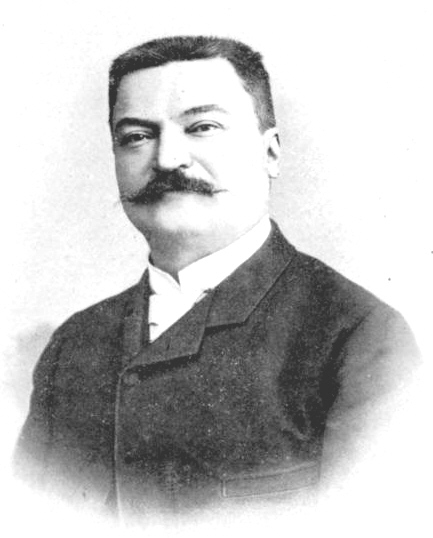Édouard Lucas (1842-1891)
number-theorist
|
The Lucas sequence,
2, 1, 3, 4, 7, 11, 18, . . .
is named in honor of François-Édouard-Anatole Lucas. Each term beginning with 3 is the sum of the two immediately preceding terms. This is the same rule of recurrence as for the Fibonacci sequence, which begins with 1, 1, yielding
1, 1, 2, 3, 5, 8, 13, . . . ;
in fact, the two sequences are intimately related to each other by hundreds of identities, some of which are listed below.
Lucas was born in Amiens, France, where he attended the Ecole Normale. After serving as an artillery officer in the Franco-Prussion War, Lucas was appointed professor of mathematics at Lycée Saint Louis, and later, at Lycée Charlemagne, both in Paris.
The image of Lucas appears here with the permission of Francis Lucas, francislucas@yahoo.fr.
|

|
|
The famous Towers of Hanoi puzzle is stated in terms of three pegs and several disks of different sizes, as shown on this page. What is the least number of moves, one disk at a time, necessary to move n disks from one page to another - all three pegs can be used, and no disk may be placed on top of a smaller disk. Lucas is credited with introducing this puzzle in 1883 in one of his mathematics-recreation publications.
|

|
One-hundred eighty-four of Lucas's publications are listed in
Duncan Harkin, "On the mathematical work of François-Édouard-Anatole Lucas," L'Enseignement mathæmatique 3 (1957) 276-288.
Among his best known works are
Édouard Lucas, Récréations Mathématiques, four volumes, Gauthier-Villars, Paris, 1882-94. Reprinted by Blanchard, Paris, 1959.
Édouard Lucas, The Theory of Simply Periodic Numerical Functions, first published in American Journal of Mathematics 1 (1878) 184-240, 289-321; translated by Sidney Kravity, edited by Douglas Lind, and republished by the Fibonacci Association, 1969.
For a selection of Lucas's contributions to number theory and other fields, start with the index in the well-known collection,
W. W. Rouse Ball and H. S. M. Coxeter, Mathematical Recreations and Essays, 13th edition, Dover Publications, New York, 1987.
Turning now to Lucas-Fibonacci identities, write the two sequences as L(0), L(1), L(2), . .. and F(0), F(1), F(2), . . . . Then for all nonnegative integers n,
L(n) = F(n+2) - F(n-2)
L(4n) + 2 = (L(2n))^2
L(4n) - 2 = 5(F(2n))^2
F(n + m) + F(n - p) = F(n)L(m) if m is even
L(n - 1)L(n + 1) + F(n - 1)F(n + 1) = 6(F(n))^2.
Forty-seven such identities are given on pages 59-60 of
Verner E. Hoggatt, Jr., Fibonacci and Lucas Numbers, Houghton Mifflin, Boston, 1969.
There are many much more elaborate identities involving Lucas numbers. These and ongoing research that extends Lucas's methods on primes and factorizations frequently appear in The Fibonacci Quarterly.
I thank Professor Deborah Hwang for providing the beautiful oak and walnut Towers of Hanoi shown on this page. This model was made by her husband, Mike Ciholas.
Clark Kimberling Home Page

